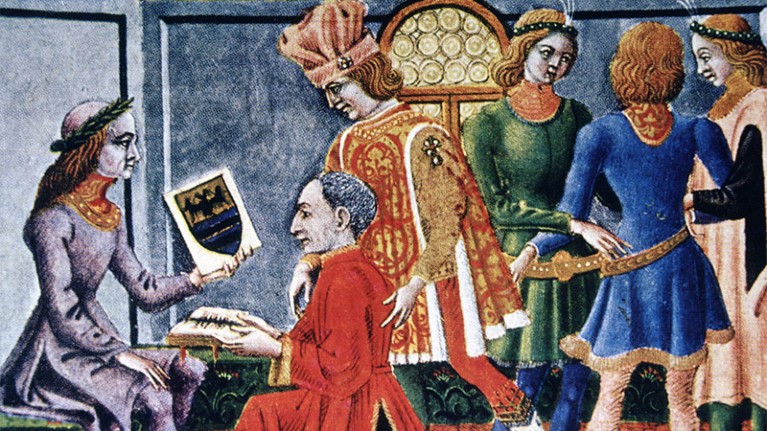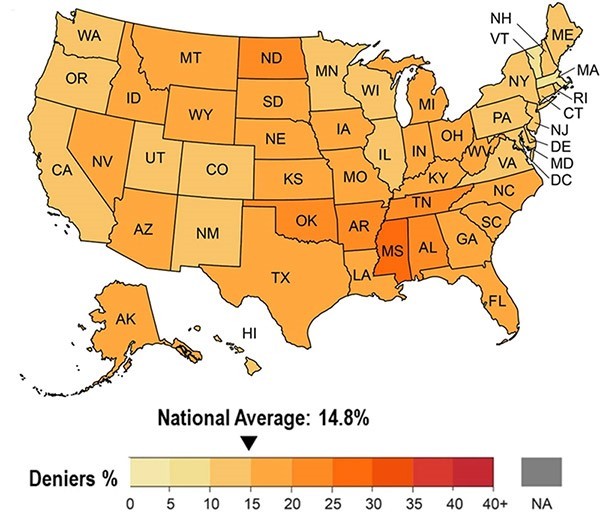Hello Nature readers, would you like to get this Briefing in your inbox free every day? Sign up here.

Astronomer Giovanni Bianchini presenting Emperor Frederick III with his book Tabulae Astrologiae.Credit: Heritage Image Partnership Ltd/Alamy
The decimal point was invented by Italian merchant and astronomer Giovanni Bianchini some 150 years before what was considered to be its first appearance. “I remember running up and down the hallways of the dorm with my computer trying to find anybody who was awake, shouting ‘look at this, this guy is doing decimal points in the 1440s!’” recalls historian Glen Van Brummelen, who discovered Bianchini’s number “with a dot in the middle” while teaching at a maths camp for kids. Bianchini’s training in economics might have given him a perspective different to that of his astronomer peers — who would have exclusively been using the sexagesimal (base 60) system — and his approach was perhaps too revolutionary to catch on until much later.
Nature | 6 min read
Reference: Historia Mathematica paper
An analysis of up to 245,000 diverse genomes has identified more than 275 million new genetic markers, nearly 150 of which might contribute to type 2 diabetes. The data have also been used to improve disease risk calculations based on people’s genetics, which tend to be less accurate for minority populations. The analysis is part of the ‘All of Us’ project, which aims to tackle inequities in genetics research: 46% of participants belong to a minority racial or ethnic group. By comparison, around 88% of the genomes in the UK Biobank, the world’s largest whole-genome dataset, are from white people. The All of Us database is “one of the most powerful resources of genomic data”, says population geneticist Alicia Martin.
Nature | 6 min read
References: Nature paper 1, Nature paper 2, Communications Biology paper & Nature Medicine paper
A quasar — a bright object found at the centre of many galaxies — has taken the title of the most luminous object ever found. At its centre is a gargantuan black hole that devours the equivalent of one solar mass every day. The quasar is 500 trillion times brighter than the Sun and twice as bright as the previous record-holding quasar. “This is the biggest unicorn with the longest horn on its head that we’ve found. I don’t think we’re going to top that record,” says astronomer and study co-author Christian Wolf.
New Scientist | 3 min read
Reference: Nature Astronomy paper
Features & opinion
Table of Contents
Brain–computer interfaces (BCIs) — implanted devices that are powered by thought alone — can restore the ability to move and speak to people with paralysis. They are also overturning assumptions about how the brain is organized. For example, BCI recordings of single-neuron activity have revealed that brain regions have fuzzier boundaries than was thought. Researchers have also started to show how BCI use changes the brain. Over time, users’ brains seem to become more efficient at controlling the device and require fewer neural resources to do the tasks. For now, the scope of BCI research remains limited, with only small clinical trials. “This is neurosurgery,” says neural engineer Jennifer Collinger. “It’s not to be taken lightly.”
Nature | 12 min read
A student who is blind worked with a computational structural biology researcher and an assistive-technology specialist to find ways to examine the 3D structures of biomolecules. Complex protein structures were revealed in all their glory through quick and inexpensive tactile graphics, and a Graphiti device — an interactive tactile graphic display. “Combining these assistive technologies with software tools that she developed to print text-based descriptions of the structural features of proteins and their spatial relationships, [student Olivia Shaw] was finally positioned to conduct research on a similar level as her peers who aren’t blind,” write the three researchers. “In one year, [Shaw] had collected data using a national supercomputer, submitted an accessible poster on her project to the American Chemical Society national meeting in 2020 (which was held virtually) and submitted a manuscript.”
Nature | 7 min read
Researchers in the United States are harnessing the strengths of drought-resistant plants that can thrive on land that is becoming too dry to farm. For example, rubber dandelion (Taraxacum kok-saghyz) could provide a source of domestic rubber for tyres and protective gloves, and sorghum (Poaceae) could be used as animal feed instead of corn and soybeans. But plant scientists face an uphill battle against heavily subsidized megacrops that dominate US agriculture.
Associated Press | 7 min read
Infographic of the week

Just under 15% of people in the United States deny that climate change is happening, according to an analysis of social-media posts on X (formerly called Twitter). “What is scary, and somewhat disheartening, is how divided the worlds are between climate change belief and denial,” says sustainability researcher and study co-author Joshua Newell. “The respective X echo chambers have little communication and interaction between them.” (Scientific American | 4 min read)
Reference: Scientific Reports paper (see the full-size image here) (Gounaridis, D., Newell, J.P./Sci Rep)
Today, I’m reconsidering what it means to be blue: blueberries don’t actually contain any blue pigments (rather, their pigments are dark red). The blue is a result of the nanosized structures in the fruits’ waxy coatings.
Help me to keep this newsletter colourful by sending your thoughts and ideas to briefing@nature.com.
Thanks for reading,
Katrina Krämer, associate editor, Nature Briefing
With contributions by Flora Graham, Gemma Conroy and Sarah Tomlin
Want more? Sign up to our other free Nature Briefing newsletters:
• Nature Briefing: Anthropocene — climate change, biodiversity, sustainability and geoengineering
• Nature Briefing: AI & Robotics — 100% written by humans, of course
• Nature Briefing: Cancer — a weekly newsletter written with cancer researchers in mind
• Nature Briefing: Translational Research covers biotechnology, drug discovery and pharma
